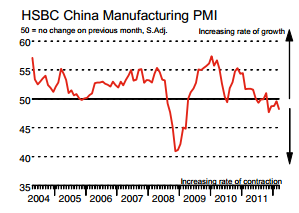Economic Events for May 7, 2012 for the European and US Markets
01:30 AUD NAB Business Confidence 3
The National Australia Bank (NAB) Business Confidence Index rates the current level of business conditions in Australia. Changes in business sentiment can be an early signal of future economic activity such as spending, hiring, and investment. The index is based on data collected from a survey of around 350 companies. A level above zero indicates improving conditions; below indicates worsening conditions.
01:30 AUD Retail Sales 0.2% 0.2%
Retail Sales measure the change in the total value of inflation-adjusted sales at the retail level. It is the foremost indicator of consumer spending, which accounts for the majority of overall economic activity.
01:30 AUD Building Approvals 3.0% -7.8%
Building Approvals (also known as Building Permits) measures the change in the number of new building approvals issued by the government. Building permits are key indicator of demand in the housing market.
05:45 CHF Unemployment Rate 3.1% 3.1%
The Unemployment Rate measures the percentage of the total work force that is unemployed and actively seeking employment during the previous month.
07:15 CHF CPI 0.2% 0.6%
The Consumer Price Index (CPI) measures the change in the price of goods and services from the perspective of the consumer. It is a key way to measure changes in purchasing trends and inflation.
10:00 EUR German Factory Orders 0.5% 0.3%
German Factory Orders measures the change in the total value of new purchase orders placed with manufacturers for both durable and non-durable goods. It is a leading indicator of production.
12:30 CAD Building Permits 7.5%
Building Permits measures the change in the number of new building permits issued by the government. Building permits are a key indicator of demand in the housing market.
Euro Dollar
EURUSD (1.30.84) The EUR/EUR is trending lower, but finding support at 1.3121, the 100‐day moving average. There is significant upcoming risk for EUR with the release of nonfarm payrolls and both the Greek and French elections. Yesterday’s ECB press conference suggested to us that President Draghi is unlikely moving towards a near‐term interest rate cut as he reiterated several times that policy is already accommodative; however the door was left open to future alternative policy announcements, including further LTROs.
The June 6th ECB meeting will prove interesting with the release of new forecasts. EUR continues to be resilient (likely due to repatriation flows,FX reserve flows, the value in Germany, the need by the US for a weak USD and the inflationary consequence of oil above $100). By the end of trading on Friday, oil had plunged under the $100 price and a negative jobs report, strengthened the dollar as investors were back to central bank mode.
The Sterling Pound
GBPUSD (1.6185) The Sterling was on its own on Friday, with little eco data and drama in Europe and the US, kept investors looking elsewhere. The pound has been able to hold above the 1.61 level, even as the greenback garnered strength on all its partners. The excitement will be upcoming BoE meeting this week. Hold your horses.
Asian –Pacific Currency
USDJPY (79.85) Japan has been on holiday most of this week due to several local and regional holidays. There hasn’t been much change here, just reaction to the global markets. The dollar lost strength here, as investors sought the yen as a safety net.
Gold
Gold (1642.65) Gold is still looking for direction, as it remains congested in the 1650-1640 range, as it was for most of April. The impression is that gold is quietly inching down, but with new pressures on the Fed to take action, there could be a pause here.
Crude Oil
Crude Oil (98.55) U.S. crude futures fell for a third session, falling more than 4 percent on the data indicating slowing economic growth and on increased OPEC production. Also, higher crude production from Saudi Arabia and data showing rise in the U.S. crude inventories in six straight weeks have led the prices to come down. Strong near term support is at 98.45 levels and immediate resistance at 95.85. This has been a dramatic shift, as speculators have pulled out of the markets. Crude has no support, high inventories, low demand and high production. We should begin to see a world glut. Though this is exactly what the US economy needs.



